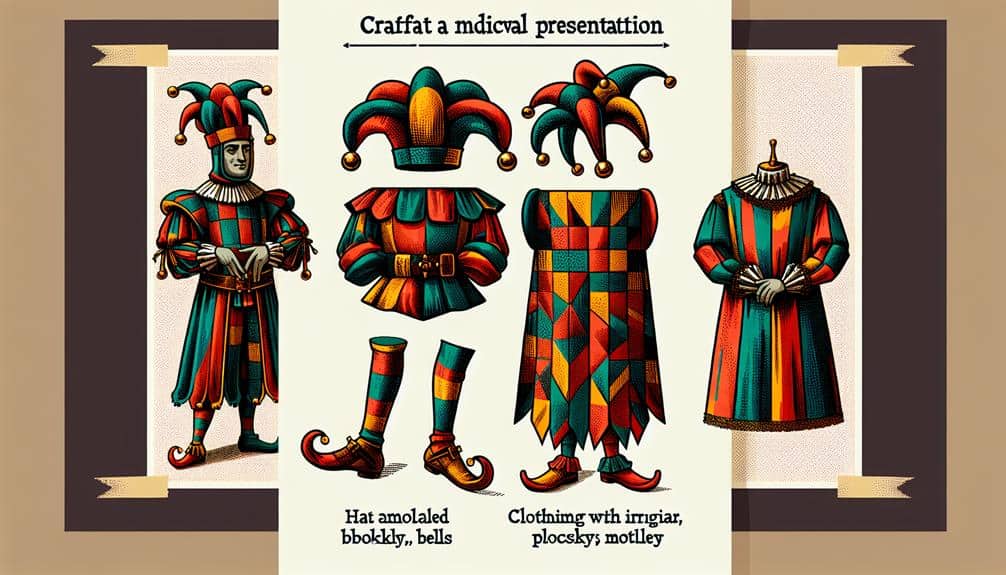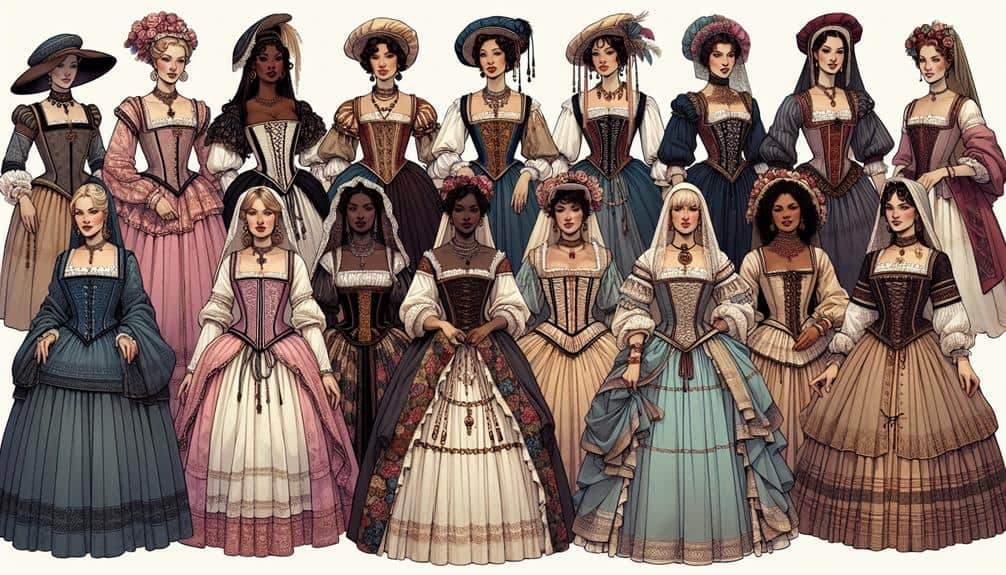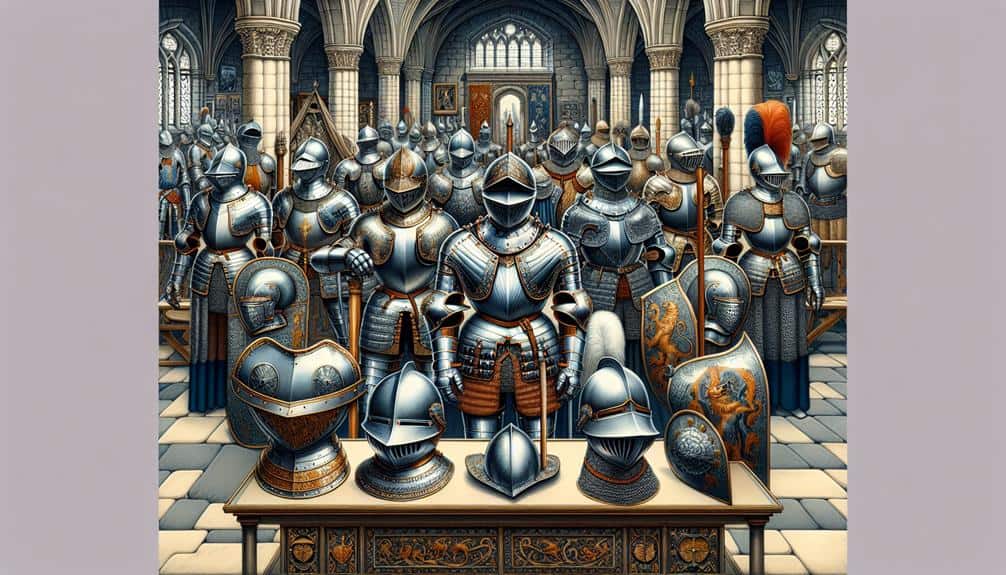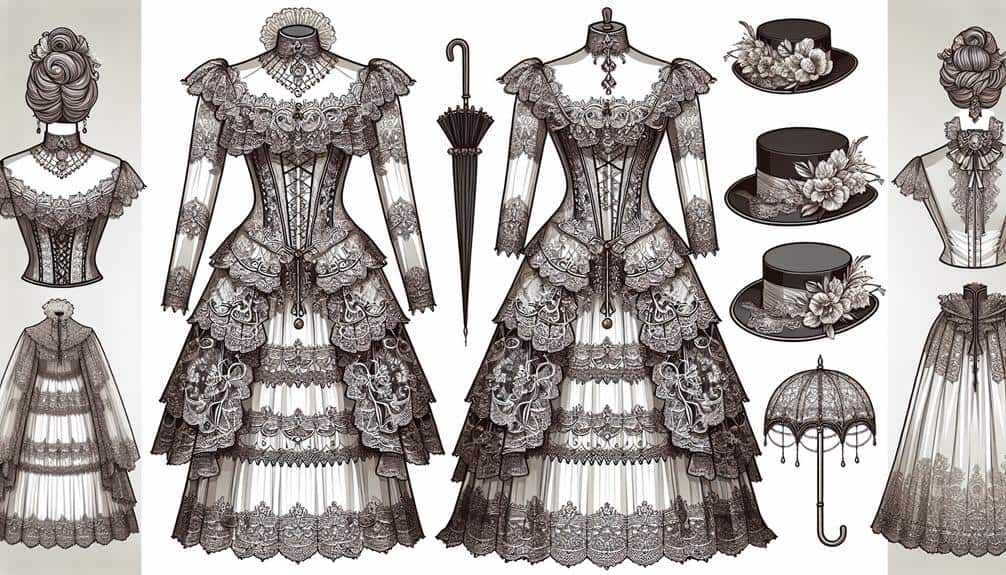To create an authentic medieval jester costume is akin to assembling a puzzle with pieces that must fit seamlessly together. From the fabric choices that transport you back in time to the essential accessories that complete the ensemble, each element plays a vital role in capturing the essence of a medieval jester.
But what exactly are these key elements that will transport you to the world of jesters and courtly entertainment? Stay tuned to discover the essential components that will guarantee your jester costume is historically accurate and visually striking.
Key Takeaways
- Authentic jester costumes feature bright colors like red, blue, green, and yellow for symbolic significance.
- Essential accessories include a jester hat with bells, a scepter, gloves, and whimsical add-ons.
- Fabric choices such as silk, wool, velvet, and linen enhance the authenticity and feel of the costume.
- Proper tailoring with correct lengths, loose-fitting tunics, and securely fitting jester hats are crucial for an authentic medieval jester look.
Historical Background of Jester Costumes
During the medieval period, jesters played a crucial role in entertainment and social commentary, influencing the evolution of their distinct and colorful costumes. Court entertainment was a significant aspect of medieval life, with jesters being central figures in providing amusement and satire to the nobility. These jesters were skilled performers, using their wit and comedic timing to entertain audiences and offer social critiques through medieval comedy. Through their performances, jesters often poked fun at societal norms and the upper class, providing a unique form of commentary that was both entertaining and thought-provoking.
The costumes worn by jesters during this time weren't only visually striking but also symbolic. Brightly colored and mismatched garments were common, reflecting the whimsical and nonsensical nature of their performances. These costumes helped distinguish jesters from other performers and added to their comedic appeal. Additionally, jesters often wore distinctive hats adorned with bells or exaggerated points, further emphasizing their role as entertainers and court jesters.
Fabric Choices for Authenticity
To achieve authenticity in replicating a medieval jester costume, carefully selecting the appropriate fabrics is essential for capturing the essence of this historical attire. When considering fabric choices, you should weigh the pros and cons of silk versus wool. Silk was a luxurious fabric favored by the wealthy elite during the medieval period, adding an air of extravagance to the jester's ensemble. On the other hand, wool was a more practical option commonly used for everyday clothing due to its durability and warmth, making it a suitable choice for a jester's costume that needed to withstand the wear and tear of performances.
Moreover, when deciding between velvet and linen, you should contemplate the desired look and feel of the costume. Velvet, with its plush texture and rich appearance, could elevate the overall aesthetic of the jester's attire, while linen, a lightweight and breathable fabric, might offer comfort during long hours of jesting. By carefully selecting the right fabrics, you can make sure that your medieval jester costume not only looks authentic but also feels true to the historical period it represents.
Essential Jester Accessories to Include
Consider enhancing your authentic medieval jester costume by incorporating essential accessories that capture the whimsical spirit of this historical figure. To truly embody the essence of a medieval jester, make sure to include the following key elements:
- Jester hat: A classic and iconic piece of a jester's ensemble, the hat is typically adorned with vibrant colors and bells that jingle with every movement, adding an element of playfulness to your costume.
- Bells: Attach small bells to various parts of your costume, such as the hat, collar, or sleeves, to create a delightful jingling sound as you perform and entertain.
- Scepter: A jester's scepter is a symbol of authority and jest, often topped with a whimsical decoration like a miniature jester head or a colorful bauble.
- Gloves: Choose gloves that complement the colors of your costume and add a touch of elegance to your overall look, ensuring your hands are well-dressed for your performances.
Color Scheme and Patterns for Accuracy
For an authentic medieval jester costume, pay close attention to the color scheme and patterns to ensure historical accuracy and capture the whimsical essence of this iconic figure. Material authenticity and cultural accuracy play vital roles in achieving the right look. Jesters often wore bright and contrasting colors such as red, blue, green, and yellow to stand out and entertain their audiences. These colors symbolized different aspects: red for passion and energy, blue for loyalty and wisdom, green for nature and rebirth, and yellow for joy and optimism.
In addition to color symbolism, the patterns on a jester's attire were significant. Harlequin diamonds, stripes, checks, and swirls were commonly used to add visual interest and reflect the playful nature of jesters. These patterns weren't only eye-catching but also added depth to the costume, emphasizing the jester's role as a performer and entertainer. By incorporating the appropriate color scheme and patterns, you can make sure that your medieval jester costume is both historically accurate and visually enthralling.
Tailoring and Fit for Authentic Look
Achieve an authentic medieval jester look by guaranteeing the tailoring and fit of your costume align closely with historical accuracy and traditional design elements. For a truly authentic appearance, consider the following fitting adjustments and period-appropriate tailoring:
- Proper Lengths: Guarantee that the tunic and pants are the correct lengths, typically reaching the mid-calf for a more historically accurate look.
- Tunic Fit: Opt for a tunic that's loose-fitting yet tailored at the waist to allow for movement while maintaining a polished appearance.
- Sleeve Style: Choose a tunic with wide, flowy sleeves that capture the essence of medieval fashion.
- Hat Fit: The jester's hat should fit securely on the head without being too tight, allowing the signature bells to jingle freely.
- Shoe Selection: Complete the ensemble with leather shoes that are comfortable for dancing and jesting, reflecting the footwear of the medieval period.
Frequently Asked Questions
Can Modern Materials Be Used to Recreate a Medieval Jester Costume Without Compromising Authenticity?
When recreating a medieval jester costume using modern materials, aim for historical accuracy. Make sure that the fabrics, colors, and design elements closely resemble those of the era. Balancing authenticity with practicality can result in a compelling and accurate costume.
Are There Specific Rules or Guidelines for Incorporating Humor and Whimsy Into a Medieval Jester Costume?
To infuse your medieval jester costume with historical accuracy, focus on incorporating comedic flair. Authenticity and medieval charm can be achieved through attention to detail in the design and materials chosen, ensuring a whimsical yet authentic portrayal.
How Did Social Status Influence the Design and Elements of a Jester's Costume in Medieval Times?
In medieval times, social hierarchy greatly influenced jester costumes. Nobles wore elaborate, colorful outfits symbolizing wealth and status. Lower-class jesters had simpler attire, reflecting their position. These costumes were a visual representation of societal structure and power dynamics.
Were There Regional Variations in Jester Costumes in Medieval Europe, and How Can This Be Reflected in a Historically Accurate Costume?
In medieval Europe, regional variations in jester costumes were influenced by cultural differences. To create a historically accurate costume reflecting these variations, consider details like colors, fabrics, and design motifs specific to different regions for authenticity.
What Role Did Jesters Play in Medieval Society, and How Did This Influence the Symbolism and Design of Their Costumes?
In medieval society, jesters played an essential role in entertaining and critiquing the elite. Their costumes reflected this dual purpose, blending whimsical symbols with sharp designs. Understanding the jester's role, symbolism, and costume design reveals a rich historical narrative.



